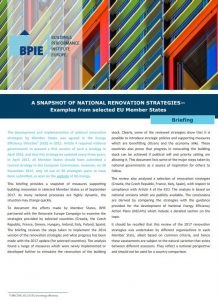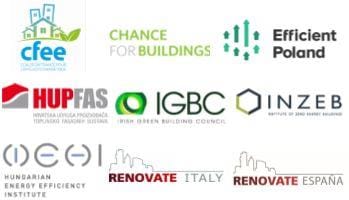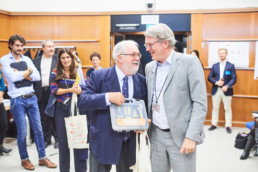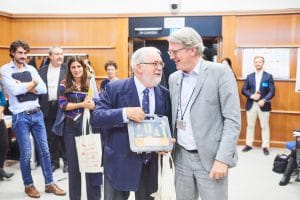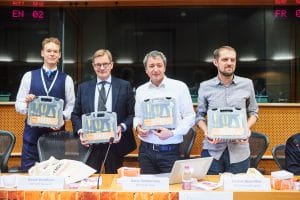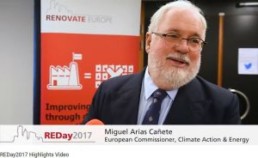A Snapshot of National Renovation Strategies: Examples from Selected EU Member States
In April 2017, all Member States should have submitted a revised national renovation strategy (version 2) to the European Commission. This briefing provides a snapshot of measures supporting building renovation in selected Member States as of September 2017.
The analysis found a range of measures which were newly implemented or developed further to stimulate the renovation of the building stock. Clearly, some of the reviewed strategies show that it is possible to introduce strategic policies and supporting measures which are benefitting citizens and the economy alike. These countries also prove that progress in renovating the building stock is possible if political will and priority setting are allowing it. This document lists some of the major steps taken by national governments, as a source of inspiration for others to follow.The review also analysed a selection of renovation strategies (Croatia, the Czech Republic, France, Italy, Spain), with respect to compliance with Article 4 of the EED. The analysis is based on national versions which are publicly available. The conclusions are derived by comparing the strategies with the guidance provided for the development of National Energy Efficiency Action Plans (NEEAPs) which contains a detailed section on the topic.
Thank you to the following Renovate Europe National Partners for their appraisals of national renovation strategy implementation in the following Member States:
- Croatia - HUPFAS (Croatian Association of Heat-Façade Systems Manufacturers)
- Czech Republic -Chance for Buildings
- France - CFEE (Coalition France pour l'Efficacité Energétique)
- Greece - INZEB (Institute of Zero Energy Buildings)
- Hungary - MEHI (Hungarian Energy Efficiency Institute)
- Ireland - Irish Green Building Council
- Italy - Renovate Italy
- Poland - Efficient Poland
- Spain - Renovate Espana
Our Buildings Need Fixing and the Toolbox is at Hand!
COREPER on EPBD
Adrian Joyce, Renovate Europe Campaign Director
28 November 2017
Sitting side by side at Renovate Europe Day 2017 (REDay2017) on 10th October, the Estonian Presidency, Commissioner Canete and MEP Bendtsen leading the EP's work on buildings, all agreed on the need for a strong Energy Performance of Buildings Directive (EPBD):
- - Commissioner Canete insisted "Buildings will unquestionably play a major role: we will not achieve our objectives without renovating our building stock"
- - The Estonian Presidency highlighted "Both Council and the Parliament seem to agree that the revised EPBD will contribute to the life quality of people living and working in buildings"
- - And MEP Bendtsen repeated "The ambition of the Parliament remains clear: buildings must deliver their share to become energy efficient and cost efficient"
Consensus prevailed that buildings were key to achieving the EU's long-term top-priority goals such as job creation, climate change mitigation and digitalisation, and that the EPBD served as the perfect vehicle to push the EU forward towards a highly energy efficient, nearly zero-energy building stock for 2050.
Strongly supported by his 4 Shadow Rapporteurs also present at REDay2017, thereby representing the 5 main political parties in the EP, MEP Bendtsen walked away from the next day's ITRE Committee Vote on the EPBD with an extremely strong report (51 votes in favour, 1 against) and an unquestionable mandate (61 votes in favour, 1 against), enshrining the European Parliament's determination to fix the poorly-performing, energy-wasting building stock of the EU[1] with an effective toolbox of policies and incentives in the EPBD.
The EPBD toolbox which the Parliament has put on the table is the right one. This toolbox serves a clear purpose: achieving a nearly Zero Energy Building (nZEB) vision for a transformed building stock by 2050 that puts energy efficiency first; and it has the correct tools to deliver:
- - long-term national renovation strategies equipped with 2030 and 2040 milestones against which to benchmark progress using measurable progress indicators, boosting energy renovation rate and depth;
- - individual building renovation passports that empower building owners with timely, tailored and cost-effective recommendations for their building, elucidating the best moments in the life of the building for action (trigger points);
- - engagement of stakeholders in the full process of developing, implementing and evaluating long-term renovation strategies as they are competent, willing and fully resourced partners with an appetite to fully engage in the process.
All that is needed to deploy this EPBD toolbox in Member States across the EU is a successful outcome to the tripartite negotiations now taking place in Brussels between the same three representatives that were in full agreement about the importance of energy renovation at REDay2017: The Council, the Commission and the European Parliament.
Logic would assume that the debate in the trialogues would follow the same consensual statements reached at REDay2017. This would mean that:
- - The three institutions would acknowledge the good compromise that the European Parliament achieved when it adopted an EPBD text that enjoys cross-party and cross-country support with a very strong mandate.
- - EU leaders would want to demonstrate their commitment to cutting energy waste in buildings so that people all over the EU would live in warmer, more comfortable homes and work in resilient, future-proofed buildings; and
- - The trialogues would embrace the Parliament's text as a comprehensive toolbox which will boost the staggeringly low energy renovation rates (around 1%) to a new high across the EU.
Why then do we hear of Member State resistance to improving the EU's faltering building stock echoing strongly and persistently throughout Europe's cold and leaky homes?
It is the turn of the Member States to grasp the toolbox with both hands and maximise the positive impact of energy renovation for the economy and for the health and comfort of citizens through the EPBD. The benefits of accelerating energy renovation across the EU have been quantified[2]: savings of €30-80 billion per year in healthcare expenditure, 8 million people could be moved out of damp, mouldy homes by 2030, 6 million lifted out of energy poverty by 2030, and local employment numbers could see a boost of 2 million direct, quality jobs.
In business, everything starts with a good long-term plan, one that sets a clear unambiguous objective, lays out milestones along the way, describes the resources needed and develops key performance indicators that allow for progress to be checked and measured. If the efforts of our Member States are to bear fruit for people, then these key elements must also feature in the final adopted text of the revised EPBD. In effect, the EPBD must become a business plan for the transformation of our building stock by 2050 to a highly energy efficient, resilient, healthy and connected stock delivering optimum living and working conditions for all Europeans.
Member States walking out of these trialogues with an EPBD text which does not set a clear 2050 nZEB vision for the building stock and does not strengthen the national renovation strategies with milestones, KPIs, resources and an implementable timeframe, will be synonymous to handing EU citizens an empty toolbox with no tools, with no plan and with no hope.
The EU and its citizens look to their governments for courageous, well-founded policies that bring benefits across the board; they do not look for more excuses for inaction. The Renovate Europe Campaign therefore calls on the Member States to ensure that the ambition shown in the Parliament's position on the revision of the EPBD is fully contained in the final text.
Now, it's over to you in the Council, and the world is watching!
[1] The Buildings Performance Institute Europe recently revealed that only 3% of buildings in the EU can currently be considered as highly energy efficient. See : http://bpie.eu/publication/97-of-buildings-in-the-eu-need-to-be-upgraded/
[2] Cambridge Econometrics Report presented at REDay2017: https://renovate-europe.eu/cambridge-econometrics-report-presented-reday2017/
Renovate Europe addresses Energy Ministers: Energy Renovations - The Climate Change Hero
Energy Renovations - The Climate Change Hero
As Heads of State gather in Bonn for COP23, Renovate Europe has written to the 28 Energy Ministers to draw their attention to the contradiction that exists between your support for the implementation of the Paris Agreement on Climate Change and the level of ambition in the tripartite negotiations in Brussels on the revision of the Energy Performance of Buildings Directive (EPBD).
The revision of the EPBD holds the potential to create an opportunity for Europe to boost energy renovation in an unprecedented manner. Delivering on the energy savings potential tied up in our building stock is the best way to ensure that our citizens get the most from concrete action on climate change.
(...) We therefore urge you to favourably consider the following key improvements for the EPBD, which have been formulated in the Parliament’s position (which enjoys full cross-party support) on the file:
- A clear, ambitious 2050 nZEB[1] Vision for the building stock that puts energy efficiency first;
- Long-term national renovation strategies, equipped with milestones at 2030 and 2040, that make a difference by boosting renovation rate and depth and equipped with measurable progress indicators;
- Maximise the positive impact of energy renovation for the economy and for the health and comfort of citizens through the adoption and use of the best tools and solutions for the building envelope, heating and/or cooling systems and control of energy flows and the use of appropriate methods to measure and report progress in line with the efficiency first principle (a matter for Annexe I of the EPBD).
[1] Nearly Zero Energy Building – the requirement of the current EPBD for all new buildings
Download the full letter that was sent to your Minister, and the accompagnying Annexe on EPBD - How to Maximise the Positive Impact for Citizens:
Letter - Energy Renovation of Buildings, the Climate Change Hero (Austria)
Letter - Energy Renovation of Buildings, the Climate Change Hero (Belgium)
Letter - Energy Renovation of Buildings, the Climate Change Hero (Bulgaria)
Letter - Energy Renovation of Buildings, the Climate Change Hero (Croatia)
Letter - Energy Renovation of Buildings, the Climate Change Hero, (Czech Republic)
Letter - Energy Renovation of Buildings, the Climate Change Hero (Cyprus)
Letter - Energy Renovation of Buildings, the Climate Change Hero (Denmark)
Letter - Energy Renovation of Buildings, the Climate Change Hero (Estonia)
Letter - Energy Renovation of Buildings, the Climate Change Hero (Finland)
Letter - Energy Renovation of Buildings, the Climate Change Hero (France)
Letter - Energy Renovation of Buildings, the Climate Change Hero (Germany)
Letter - Energy Renovation of Buildings, the Climate Change Hero (Greece)
Letter - Energy Renovation of Buildings, the Climate Change Hero (Hungary)
Letter - Energy Renovation of Buildings, the Climate Change Hero (Ireland)
Letter - Energy Renovation of Buildings, the Climate Change Hero (Italy)
Letter - Energy Renovation of Buildings, the Climate Change Hero (Latvia)
Letter - Energy Renovation of Buildings, the Climate Change Hero (Lithuania)
Letter - Energy Renovation of Buildings, the Climate Change Hero (Luxembourg)
Letter - Energy Renovation of Buildings, the Climate Change Hero (Malta)
Letter - Energy Renovation of Buildings, the Climate Change Hero (the Netherlands)
Letter - Energy Renovation of Buildings, the Climate Change Hero (Poland)
Letter - Energy Renovation of Buildings, the Climate Change Hero (Portugal)
Letter - Energy Renovation of Buildings, the Climate Change Hero (Romania)
Letter - Energy Renovation of Buildings, the Climate Change Hero (SK)
Letter - Energy Renovation of Buildings, the Climate Change Hero (Slovenia)
Letter - Energy Renovation of Buildings, the Climate Change Hero (Spain)
Letter - Energy Renovation of Buildings, the Climate Change Hero (Sweden)
Letter - Energy Renovation of Buildings, the Climate Change Hero (the UK)
Watch REDay2017 Highlights Video
Highlights video of Renovate Europe Day 2017, on 10th October in the European Parliament.
Watch the video: https://youtu.be/QdAcCl4iztU
Cambridge Econometrics Report presented at REDay2017
The societal and economic benefits of more ambitious legislation for energy renovation
The report 'The macro-level and sectoral impacts of energy efficiency policies', commissioned by DG Energy, was presented by Managing Director Phil Summerton from Cambridge Econometrics at REDay2017.
According to the report, more ambitious legislation for energy renovation would result in:
- Savings of €30-€80 billion in healthcare
- 8 million could be moved out of having damp mouldy homes by 2030
- 6 million could be moved out of cold homes
- Really very significant increase in employment: Boost of 2 million jobs
Download Phil Summerton's PPT presentation and Phil Summerton's presentation at REDay2017.
Learn more about REDay2017 here or watch the REDay2017 Highlights Video.
[COP23] Energy Renovations - The Climate Change Mitigator
2 November 2017 by Adrian Joyce, Renovate Europe Campaign Director

The pace of energy renovations must be urgently stepped up with a focus on delivery on the ground if the Paris agreement's climate goals are to be met, the International Energy Agency has said, as the COP23 summit prepares to open in Bonn. And the best way of doing that, might just be an aggregation mechanism that bundles diffuse projects for investors.
Renovations will be pivotal to the success of the Paris agreement's goal of limiting global warming to 2C. Buildings account for a fifth of global greenhouse gas emissions, and are among the cheapest mitigation options. Their renovation also produces immediate results.
But experts say that while there have been advances since the Paris COP21, more still needs to be done – and much more quickly.
“At COP21, the language switched from ambition to implementation,” said Brian Motherway, the head of energy efficiency at the International Energy Agency. “I'd like to see an acceleration in that direction, focused on delivery.”
“We have some concerns that while governments are designing policies and frameworks, not enough focus is being put on policy implementation and delivery on the ground,” he added.
The availability of finance, insurance and contractors is still an issue for many involved in energy renovations. “There has been some progress [since COP21],” Motherway said, “but we certainly think that the pace is not what it needs to be if we are going to meet our targets.”
At COP23, a Building Action Symposium on November 9 will offer a key platform to stocktake progress since 2015, with several reports and studies expected.
The key challenge the efficiency industry will have to grapple with is how to speed up revenue flows, according to Oliver Rapf, the executive director of Building Performance Institute Europe.
“One of our sector's biggest problems is that investment projects are normally small-scale and individual,” he said. “We need to find a mechanism to aggregate these projects and put them into a really big investment pool so that they become more interesting for institutions.”
Analysts say that fixed single ventures such as offshore wind farms often appear more attractive to pension funds and insurance companies than renovation projects, which are often perceived as small-scale, diffuse and complicated.
Returns from energy retrofits are readily achievable but paybacks from a solar park coming online are easier to gainsay than the savings from thousands of foregone energy bills, which may carry a less predictable value.
“The problem here is not availability of capital,” Motherway said. “It's the gap between the capital and the projects; the way the two sides talk to each other, how projects are bundled, and the right scale for that.”
Investors are often not well versed in the risks and returns of energy efficient renovation projects. Equally, those who deliver them may not understand investor concerns about collateral and risk management. An aggregation mechanism could help to change that.
“Confidence on both sides is an issue,” Motherway explained. “The space in between is about well designed models that have been tested, piloted and built over time to deliver confidence among all actors. I'm talking about something new here - but it is well within our capabilities.”
In countries such as France, efforts are already underway to bundle packages of up to 50 houses in single investment projects to help overcome challenges posed by the relatively small scale of the energy renovations market, and the still-maturing supply chains that they depend on.
A call in the COP conclusions for aggregation mechanisms to be set up - or a statement that the COP parties would do so - would be welcomed across the renovations sector.
“High level signals are important to activate markets and reward early adopters, perhaps using the public sector as a leader or exemplar,” Motherway said.
Another important role of the COP discussions is to share practical experiences and allow governments to learn about what works from each other, so that successful policies can be replicated.
Globally, around two thirds of homes under construction are being built with no effective application of building codes. Their future energy use – and CO2 emissions – are being locked in while policy makers are focused elsewhere.
Again, many in the building sector argue that positions taken in the final COP conclusions could have a broad-based effect on raising the profile of the issue.
“A strong endorsement or requirement that national climate strategies – the NDCs – reflect the potential in the building sector [for reducing greenhouse gas emissions] would also probably generate some momentum,” Rapf said.
END
Read more on COP: Paris agreement under threat as Member States try to water down key buildings measures in EPBD

